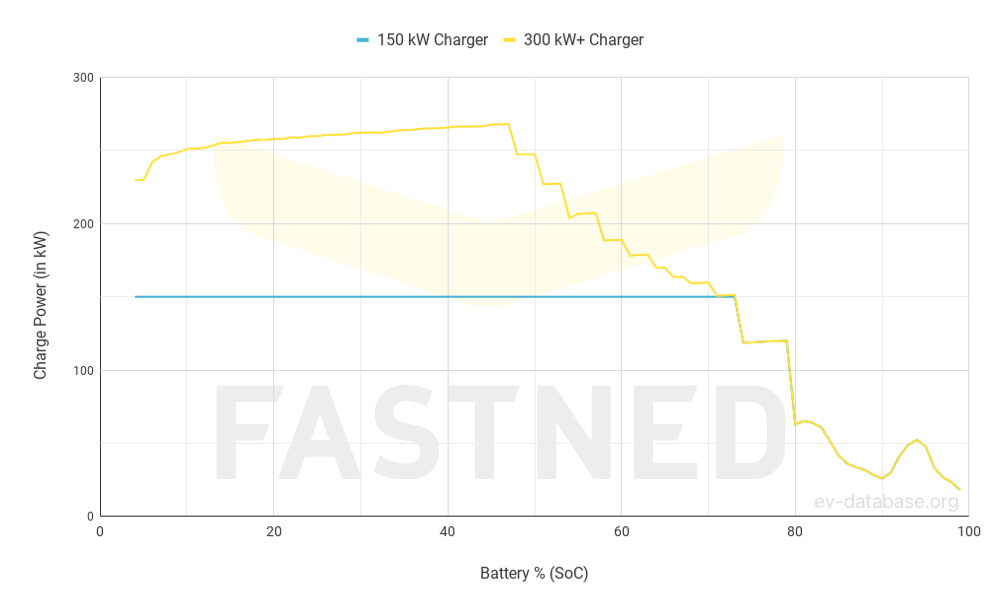Porsche Taycan Turbo S
January 2020 - January 2023£142,400Price from
83.7 kWhUseable Battery
245 miReal Range
342 Wh/miEfficiency
This electric vehicle is no longer for sale
A new model is available: orcheck out the full archive here
Price from (last known) £142,400
| Availability | Not available to order |
| Available to order from | January 2020 |
| Available to order until | January 2023 |
| Annual VED | £0 |
| Congestion Charge | £0 |
| Insurance Group | 50 |
Real Range between 180 - 345 mi
| City - Cold Weather | 240 mi |
| Highway - Cold Weather | 180 mi |
| Combined - Cold Weather | 210 mi |
| City - Mild Weather | 345 mi |
| Highway - Mild Weather | 230 mi |
| Combined - Mild Weather | 280 mi |
Performance
| Acceleration 0 - 62 mph | 2.8 sec |
| Top Speed | 162 mph |
| Electric Range | 245 mi |
| Total Power | 560 kW (751 hp) |
| Total Torque | 774 lb-ft |
| Drive | AWD |
Battery
| Nominal Capacity | 93.4 kWh |
| Battery Type | Lithium-ion |
| Number of Cells | 396 |
| Architecture | 800 V |
| Warranty Period | 8 years |
| Warranty Mileage | 100,000 mi |
| Useable Capacity | 83.7 kWh |
| Cathode Material | NCM721 |
| Pack Configuration | 198s2p |
| Nominal Voltage | 725 V |
| Form Factor | No Data |
| Name / Reference | No Data |
Charging
Home / Destination
| Charge Port | Type 2 |
| Port Location | Left Side - Front |
| Port Location 2 | Right Side - Front |
| Charge Power † | 11 kW AC |
| Charge Time (0->245 mi) † | 9 hours |
| Charge Speed † | 27 mph |
Rapid Charging
| Fastcharge Port | CCS |
| FC Port Location | Left Side - Front |
| Fastcharge Power (max) | 268 kW DC |
| Fastcharge Power (10-80%) | 216 kW DC |
| Fastcharge Time (24->196 mi) | 17 min |
| Fastcharge Speed | 600 mph |
| Autocharge Supported | Yes |
Plug & Charge
| Plug & Charge Supported | Yes |
| Supported Protocol | ISO 15118-2 |
Bidirectional Charging (V2X / BPT)
Vehicle-to-Load (V2L)
| V2L Supported | No |
| Max. Output Power | - |
| Exterior Outlet(s) | - |
| Interior Outlet(s) | - |
Vehicle-to-Home (V2H)
| V2H via AC Supported | No |
| Max. Output Power | - |
| V2H via DC Supported | No |
| Max. Output Power | - |
Vehicle-to-Grid (V2G)
| V2G via AC Supported | No |
| Max. Output Power | - |
| V2G via DC Supported | No |
| Max. Output Power | - |
Energy Consumption
EVDB Real Range
| Range | 245 mi |
| Vehicle Consumption | 342 Wh/mi |
| CO2 Emissions | 0 g/km |
| Vehicle Fuel Equivalent | 118 mpg |
WLTP Ratings (TEL)
| Range | 258 mi |
| Rated Consumption | 391 Wh/mi |
| Vehicle Consumption | 324 Wh/mi |
| CO2 Emissions | 0 g/km |
| Rated Fuel Equivalent | 103 mpg |
| Vehicle Fuel Equivalent | 125 mpg |
WLTP Ratings (TEH)
| Range | 242 mi |
| Rated Consumption | 412 Wh/mi |
| Vehicle Consumption | 345 Wh/mi |
| CO2 Emissions | 0 g/km |
| Rated Fuel Equivalent | 98 mpg |
| Vehicle Fuel Equivalent | 117 mpg |
Rated = official figures as published by manufacturer. Rated consumption and fuel equivalency figures include charging losses.
Vehicle = calculated battery energy consumption used by the vehicle for propulsion and on-board systems.
NOTE: The fuel equivalency figures are shown in IMPERIAL MPG. Figures in US MPG will differ significantly.
Real Energy Consumption between 243 - 465 Wh/mi
| City - Cold Weather | 349 Wh/mi |
| Highway - Cold Weather | 465 Wh/mi |
| Combined - Cold Weather | 399 Wh/mi |
| City - Mild Weather | 243 Wh/mi |
| Highway - Mild Weather | 364 Wh/mi |
| Combined - Mild Weather | 299 Wh/mi |
Safety (Euro NCAP)
| Safety Rating | |
| Adult Occupant | 85% |
| Child Occupant | 83% |
| Rating Year | 2019 |
| Vulnerable Road Users | 70% |
| Safety Assist | 73% |
Dimensions and Weight
| Length | 4963 mm |
| Width | 1966 mm |
| Width with mirrors | 2144 mm |
| Height | 1378 mm |
| Wheelbase | 2900 mm |
| Weight Unladen (EU) | 2370 kg |
| Gross Vehicle Weight (GVWR) | 2870 kg |
| Max. Payload | 575 kg |
| Cargo Volume | 366 L |
| Cargo Volume Max | No Data |
| Cargo Volume Frunk | 84 L |
| Roof Load | 75 kg |
| Tow Hitch Possible | No |
| Towing Weight Unbraked | 0 kg |
| Towing Weight Braked | 0 kg |
| Vertical Load Max | 0 kg |
Miscellaneous
| Seats | 5 people |
| Isofix | Yes, 2 seats |
| Turning Circle | 11.2 m |
| Platform | VW J1 |
| EV Dedicated Platform | Yes |
| Car Body | Saloon |
| Segment | Luxury |
| Roof Rails | No |
| Heat pump (HP) | Yes |
| HP Standard Equipment | Yes |
Company Car Tax Indication
Financial Year 2019-20
| BIK Tax Rate | 1% |
| P11D Value from | £142,345 |
| Benefit in Kind (BIK) | £1,423 |
| BIK @ 20% | £24 pcm |
| BIK @ 40% | £47 pcm |
| BIK @ 45% | £53 pcm |
Financial Year 2020-21
| BIK Tax Rate | 1% |
| P11D Value from | £142,345 |
| Benefit in Kind (BIK) | £1,423 |
| BIK @ 20% | £24 pcm |
| BIK @ 40% | £47 pcm |
| BIK @ 45% | £53 pcm |
Financial Year 2021-22
| BIK Tax Rate | 1% |
| P11D Value from | £142,345 |
| Benefit in Kind (BIK) | £1,423 |
| BIK @ 20% | £24 pcm |
| BIK @ 40% | £47 pcm |
| BIK @ 45% | £53 pcm |
Home and Destination Charging (0 -> 100%)
Charging is possible by using a regular wall plug or a charging station. Public charging is always done through a charging station. How fast the EV can charge depends on the charging station (EVSE) used and the maximum charging capacity of the EV. The table below shows all possible options for charging the Porsche Taycan Turbo S. Each option shows how fast the battery can be charged from empty to full.
| Type 2 (Mennekes - IEC 62196) |
|---|
 |
| Charging Point | Max. Power | Power | Time | Rate |
|---|---|---|---|---|
| Standard 11.0 kW On-Board Charger | ||||
| Wall Plug (2.3 kW) | 230V / 1x10A | 2.3 kW | 43 hours | 6 mph |
| 1-phase 16A (3.7 kW) | 230V / 1x16A | 3.7 kW | 26h45m | 9 mph |
| 1-phase 32A (7.4 kW) | 230V / 1x32A | 7.4 kW | 13h30m | 18 mph |
| 3-phase 16A (11 kW) | 400V / 3x16A | 11 kW | 9 hours | 27 mph |
| 3-phase 32A (22 kW) | 400V / 3x16A | 11 kW † | 9 hours | 27 mph |
| Optional 22.0kW On-Board Charger | ||||
| Wall Plug (2.3 kW) | 230V / 1x10A | 2.3 kW | 43 hours | 6 mph |
| 1-phase 16A (3.7 kW) | 230V / 1x16A | 3.7 kW | 26h45m | 9 mph |
| 1-phase 32A (7.4 kW) | 230V / 1x32A | 7.4 kW | 13h30m | 18 mph |
| 3-phase 16A (11 kW) | 400V / 3x16A | 11 kW | 9 hours | 27 mph |
| 3-phase 32A (22 kW) | 400V / 3x32A | 22 kW † | 4h30m | 54 mph |
† = Limited by on-board charger, vehicle cannot charge faster.
Rapid Charging (10 -> 80%)
Rapid charging enables longer journeys by adding as much range as possible in the shortest amount of time. Charging power will decrease significantly after 80% state-of-charge has been reached. A typical rapid charge therefore rarely exceeds 80% SoC. The rapid charge rate of an EV depends on the charger used and the maximum charging power the EV can handle. The table below shows all details for rapid charging the Porsche Taycan Turbo S.
- Max. Power: maximum power provided by charge point
- Avg. Power: average power provided by charge point over a session from 10% to 80%
- Time: time needed to charge from 10% to 80%
- Rate: average charging speed over a session from 10% to 80%
| Combined Charging System (CCS Combo 2) |
|---|
 |
| Charging Point | Max. Power | Avg. Power | Time | Rate |
|---|---|---|---|---|
| CCS (150 kW DC) | 150 kW | 142 kW † | 26 min | 390 mph |
| CCS (300 kW DC) | 268 kW † | 216 kW † | 17 min | 600 mph |
| Charge Curve |
|---|

|
|
Data made available by Fastned |
| This vehicle supports Autocharge |
|---|
| This vehicle supports Plug & Charge |
† = Limited by charging capabilities of vehicle
Autocharge: allows for automatic initiation of a charging session at supported CCS charging stations.
Plug & Charge: allows for automatic initiation of a charging session at supported CCS charging stations in accordance with ISO 15118.
Actual charging rates may differ from data shown due to factors like outside temperature, state of the battery and driving style.
All about the Porsche Taycan Turbo S
No longer available
This electric vehicle is no longer in production and not available to buy new. The Porsche Taycan Turbo S was available from January 2020 until January 2023. Financial data like price, leasing and company car tax were applicable to the final year of availability of the Porsche Taycan Turbo S.
A new model of the Porsche Taycan Turbo S (2020) is available: Porsche Taycan Turbo S (2023).
Pricing
The Porsche Taycan Turbo S had an On The Road Price (OTR) of £142,400. The OTR Price includes VAT, first year of VED, vehicle first registration fee, number plates and delivery.
Drivetrain and Performance
The Porsche Taycan Turbo S is a full electric vehicle (BEV). The maximum power of the Porsche Taycan Turbo S is 560 kW (751 hp). The maximum torque is 774 lb-ft. The Porsche Taycan Turbo S is all wheel drive and can accelerate from 0 to 62 miles per hour in 2.8 seconds. The top speed is 162 mph.
Battery and Charging
The battery of the Porsche Taycan Turbo S has a total capacity of 93.4 kWh. The usable capacity is 83.7 kWh. A range of about 245 miles is achievable on a fully charged battery. The actual range will however depend on several factors including climate, terrain, use of climate control systems and driving style.
For example: sustaining high speeds in cold weather could result in a range of around 180 mi. However, driving at low speeds in mild weather will increase the range to around 345 mi.
Charging is done using a Type 2 connector and the on-board charger has a maximum power of 11 kW. This charges a fully depleted battery back to full in around 9 hours. However, a 3-phase grid connection is needed to achieve this. The majority of homes and charge points currently do not have this connection. In most cases the maximum charging power will be 7.4 kW, allowing for a charge time of 13 hours 30 minutes and a charge rate of 18 mph. An optional on-board charger with a maximum power of 22.0 kW is available. This charges a fully depleted battery back to full in around 4 hours 30 minutes. Charging the car using a regular wall plug will take around 43 hours.
Rapid charging is possible through a CCS connection. The maximum rapid charge power is 268 kW. The battery can't be charged continuously at this power. In an average rapid charge session the average charge power will be around 216 kW. This charges the battery from 10% to 80% in around 20 minutes. A rapid charge like this will add about 170 miles of range.
Energy Consumption
The combined (motorway and city) energy consumption of the Porsche Taycan Turbo S is about 342 Wh per mile. By comparison, this energy consumption is the equivalent of a fuel consumption of 118 mpg in a traditional petrol car.
The actual energy consumption will depend on several factors including climate, terrain, use of climate control systems and driving style. For example: sustaining high speeds in cold weather could result in an energy use of around 465 Wh per mile. However, driving at low speeds in mild weather will increase the efficiency to about 243 Wh per mile.
CO2 Emission
The Porsche Taycan Turbo S emits no CO2 during driving. This only includes direct emissions from the vehicle itself. The energy needed to charge the battery might have been (partly) generated by the use of fossil fuels. Vehicles with an internal combustion engine will always emit CO2 during driving. Additionally, CO2 is emitted during the production and transport of fossil fuels.
More information from Porsche
The link below will open the page of the Taycan on the official Porsche site.

 Porsche Taycan Turbo S
Porsche Taycan Turbo S